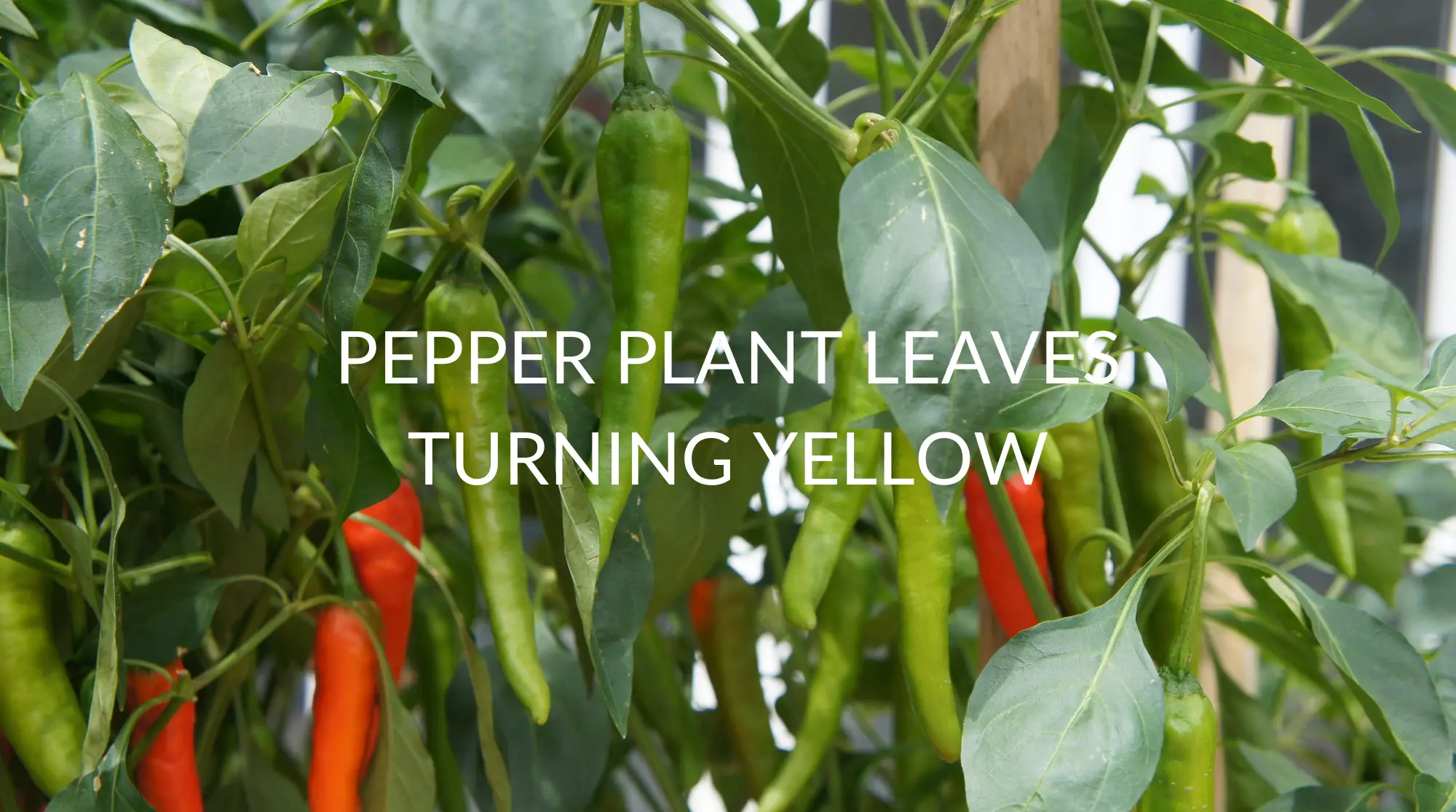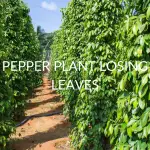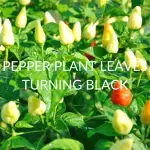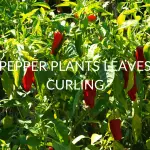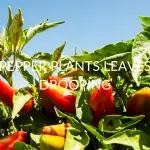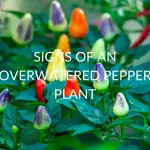Chili peppers, bell peppers, and other sweet peppers are popular plants for home gardens. Their low cost and easy maintenance make them a popular choice for many gardeners. They can be grown in pots or outdoors, making them versatile. Pepper plant leaves turning yellow can have many gardeners wondering what is wrong with their plants and how to treat them.
Pepper plant leaves turning yellow indicate there is an issue with the plant. From lack of nutrients, watering, disease, or insect infestation, decoding your pepper plant’s yellow leaves isn’t a difficult task. They are all mostly treatable when the issue is discovered.
Below we look at the reasons for pepper plant leaves turning yellow, what causes it, treatment, and even discuss prevention methods to keep your plants happy and healthy.
Why Are My Pepper Plant Leaves Turning Yellow?
There are a few reasons pepper plant leaves will turn yellow. They include nutrient deficiencies, overwatering, extreme temperatures, diseases, and even pest infiltration that can cause your pepper plant leaves to turn yellow. Below, we look at each one individually to learn more about them and how to identify what is causing your pepper plant leaves to yellow.
Nutrient Deficiencies
Nutrient deficiencies can cause yellowing in pepper plant leaves. Nitrogen, magnesium, and calcium are all essential to the health of pepper plants. We will look at each nutrient individually to see how it causes yellowing in your pepper plant leaves.
Nitrogen Deficiencies
Nitrogen is essential in pepper plants, and a lack of nitrogen can cause serious problems for pepper plants. If the leaves of your plant start yellowing at the bottom of the plant and begin to move upwards, it is a sign of a nitrogen deficiency. If left untreated, the bottom leaves will be yellow and fall off even while the top ones may remain green.
Magnesium Deficiencies
Magnesium deficiencies are less common in soil gardening; they are still a possibility. If the leaves begin to turn yellow and the veins of the leaves remain green, this is a sign of chlorosis. This will be the best way to distinguish a magnesium deficiency from a nitrogen deficiency.
Calcium Deficiencies
Calcium plays a vital role in a pepper plant’s growth. It helps build cell walls and in growing a strong root system. Signs of calcium deficiencies are curled leaves with brown spots on them.
Calcium can also cause blossom end rot in your pepper plants. Correcting the calcium deficiencies will result in the plant producing healthy fruit in the future.
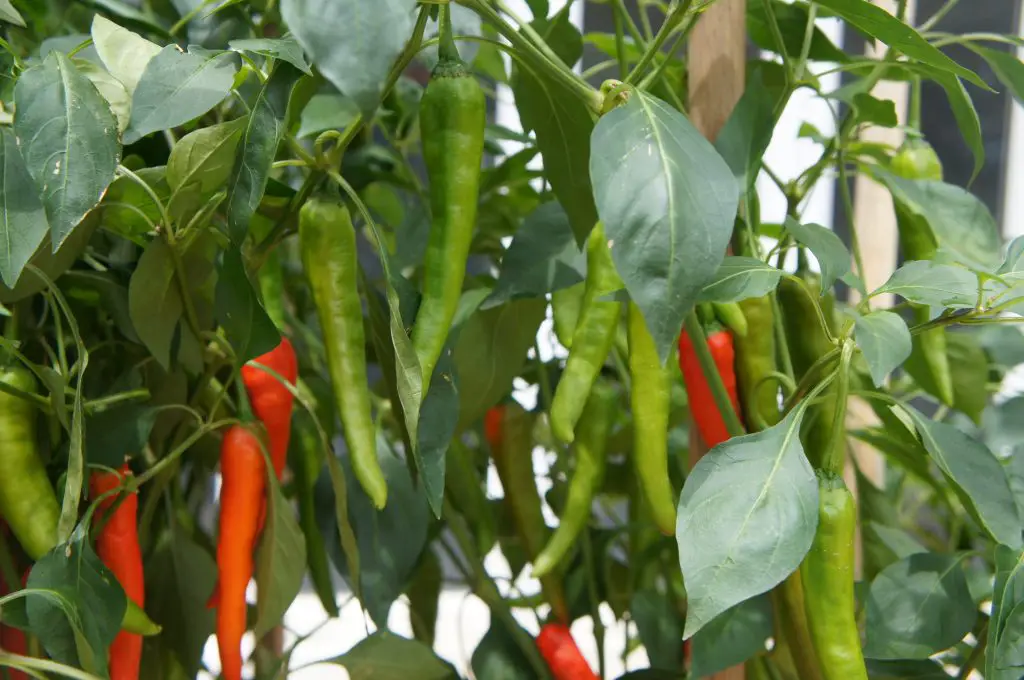
Overwatering
Overwatering or underwatering can cause stress on your plant. The soil must be kept moist, and the pot should allow for drainage. Poor drainage and overwatering will lead to a pepper plant’s leaves turning yellow and stunt the growth and productivity of the plant. It will also cause a milder pepper to be produced from your plant.
Underwatering is preferred over overwatering. It can also lead to issues in pepper plants. Wilting leaves are a sign a pepper plant is underwatered. In hotter temperatures, plants will need more water to keep them moist and not let their soil dry out and their leaves wilt.
Underwatering will also cause your plant to increase its capsaicin production resulting in hotter peppers produced by your plant. The hottest peppers are produced by allowing the pepper plants’ leaves to wilt before watering.
Cold Weather
Pepper plants come from a warm climate, and temperature changes can cause stress in your plants. Temperatures below 50°F will cause yellowing on random leaves in your pepper plants. Temperatures below 40°F will cause significant harm, and temperatures below freezing will kill your pepper plants.
If cold temperatures are expected in your area, pepper plants will need to be brought indoors or covered with plastic to ensure they do not become too cold and die.
Diseases
Bacterial leaf spots will cause yellowing and brown spots on your pepper plant leaves. Bacterial leaf spot disease can be treated with an organic fungicide.
Phytophthora blight will wilt your plants in addition to turning their leaves yellow.
Phytophthora blight is untreatable in pepper plants and must be prevented through chemical fungicides and plant rotation.
Pest infiltration
Infiltrations on your pepper plants by mites, aphids, and psyllids will attack your pepper plants and rob them of their nutrients, causing their leaves to turn yellow. Treatment with an insecticide will rid the plants of pests and return your plant to good health.
What To Do When Pepper Plant Leaves Turn Yellow
When pepper plant leaves turn yellow, it is optimal to discover the source of what caused the issue so proper treatment can be applied to return your pepper plant to its optimal health.
Watering
One of the top reasons that pepper plant leaves are turning yellow is overwatering and underwatering. Pepper plants should be watered once a week and allowed to drain fully. Multiple factors can affect a watering schedule, such as weather, wind, and container size. Pepper plants are best to be underwatered but do not let your plant’s soil dry out.
Finding a watering schedule is essential to ensure the best health and fruit production of your pepper plant.
Fertilizer
If your plant is lacking in nutrients, the best way to replace them is with fertilizer. Fertilizer, much like water, should only be added once a week to keep your plants healthy. Starting a fertilizer schedule will ensure the health of your plants in the future but will not turn any yellow leaves back to green.
Cal-Mag Spray
Magnesium and calcium deficiencies can be temporarily treated with a cal-mag spray used directly on the pepper plants’ leaves. In the long run, these deficiencies will need to be treated by correcting the pH balance in the soil to keep your pepper plant happy and healthy.
Eggshells and Epsom salt can also be used to provide calcium and magnesium into your pepper plants’ soil.
Neem Oil
Neem oil can be used to combat any infestation of pests you have on your pepper plants. Ensure to coat the top and bottom of the pepper plants’ leaves. You can also lightly coat the stem and soil to ensure no creature is hiding in those areas and can return to the plant after treatments.
Disease
If your pepper plant has yellowing from a disease, it may be treatable. Bacterial and fungal infections can be treated with fungicides. Viral infections are untreatable in pepper plants. Other diseases can be treated and cured by using fertilizer and watering schedules to bring the nutrients needed to the pepper plants.
How To Prevent Pepper Plant Leaves From Turning Yellow
Planting and Growing
Utilizing proper planting and growing procedures and the best method to keep your plants healthy and growing to the best of their ability. Pepper plants should be planted 18-24 inches apart and receive 6 to 8 hours of sunlight a day.
Raised beds, inground, or pots are all adequate for allowing seedlings to grow. When pepper plants begin to produce peppers, they should be supported with a stake or tomato cage.
Watering and Fertilizer
Most yellowing leaves and diseases can be prevented, treated, and cured by adequate watering and fertilizer treatment. Pepper plants should be watered once a week to keep them happy and healthy. Overwatering is worse for the plants and underwatering are encouraged, especially to achieve hotter peppers.
Underwatering causes the pepper plant to release more capsaicin and will become a hotter pepper. The hottest peppers come from plants whose leaves are left to wilt before watering.
Fertilizer treatments will not return an already yellow leaf but will ensure the future health of the plant and enable it to produce plentiful peppers in the future. Fertilizer will also help replace any nutrients that may be lacking in the soil.
Temperature
High and low temperatures are unhealthy for pepper plants and can cause yellowing leaves and other issues in your pepper plants. Maintaining stable temperatures and avoiding cold weather will ensure the health of your pepper plants and avoid any diseases and issues with your plants.
When able, potted pepper plants should be brought indoors or into warm areas if temperature drops are forecasted for your area. If your pepper plants can not be brought indoors, they will need to be covered or wrapped with plastic to ensure they are not subject to colder temperatures.
Insecticides
Treating your plant with insecticides, such as neem oil will help prevent any future infestation and help keep your pepper plants in good health. Neem oil will also help curb any fungal infections. When used properly, it is non-toxic to humans and does not harm flying bugs like ladybugs, butterflies, and bees.
FAQ
What Does an Overwatered Pepper Plant Look Like?
Overwatered pepper plants will have yellow leaves, they are droopy, and have poor health. Pepper plants should be watered once weekly, and their soil should have adequate drainage to ensure they are not overwatered. The soil should be damp but not wet to the touch. Underwatering pepper plants are preferred to overwatered plants to keep your pepper plants in their best health.
How Does Watering Affect the Heat of Peppers?
Overwatering and underwatering of pepper plants can affect the heat of their peppers. Overwatered plants will produce mild-temperature peppers and cause the pepper plant to struggle as it grows.
Underwatering pepper plants will produce more capsaicin and result in a hotter temperature pepper. The hottest temperature peppers come from plants that are constantly under water. They will be left until their leaves begin to wilt before being watered again.
Why Are My Potted Pepper Plants Turning Yellow?
The most common causes of pepper plant leaf turning yellow are overwatering and nutrient deficiencies. Maintaining a proper watering and fertilizing schedule will keep your pepper plant leaves from turning yellow.
Yellowing leaves can also be caused by diseases and pest infections. Insecticides can be used for the treatment and prevention of diseases and pests, keeping your pepper plants healthy.
Lastly, cold temperatures can also cause pepper plant leaves to turn yellow. Do not subject your pepper plants to high or low temperatures. Bring them indoors or cover them if the temperature is expected to drop in your area.
Why Are My Pepper Plants Turning Light Green?
The most common reason for pepper plant leaves to turn light green or yellowing is nutrient deficiencies. Too little molybdenum, iron, and zinc will cause the lightening of pepper leaves. Nitrogen, magnesium, and calcium deficiencies will cause yellowing or pepper plant leaves. Fertilizing your plants at least once a week will ensure they are getting the nutrients they need and keep their leaves green in the future.
Why Are My Leaves Yellow, Even With Fertilizer?
Fertilizer will not be able to change pepper leaves from yellow to green even after treatment. Fertilizer will help new leaves grow a healthy green. Overwatering can still cause pepper plant leaves to turn green with a proper fertilizer treatment schedule.
If you are on a healthy watering and treatment schedule, the pH of your soil may be to blame. Soil that is too acidic will not allow pepper plants to use nutrients in the soil. The soil should be tested to ensure it is at a proper level to support pepper plants.
Conclusion
Pepper plant leaves turning yellow are mostly caused by a lack of nutrients or overwatering. Overwatering should be looked at first when dealing with yellowing leaves. Underwatering is preferred over overwatering. Fertilizing will not affect already yellow leaves but will ensure the health of the leaves in the future.
If you are already on an adequate watering schedule, temperature changes, disease, or insect infestation can also cause your pepper plant leaves to turn yellow. Ensure your pepper plants aren’t subject to hot or cold temperatures. Most diseases and insect infestations are easily treated with chemicals to ensure your plant will remain healthy.
Proper watering, fertilization, and a few prevention methods will keep your pepper plants happy and healthy throughout their life. Happy Gardening.

